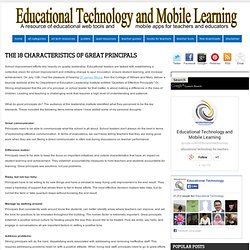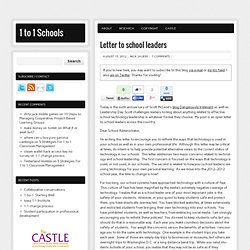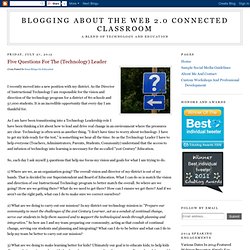

The 18 Characteristics of Great Principals. School improvement efforts rely heavily on quality leadership.

Educational leaders are tasked with establishing a collective vision for school improvement and initiating change to spur innovation, ensure student learning, and increase achievement. On July 13th I had the pleasure of hearing Dr. James Strong, from the College of William and Mary, deliver a keynote address at the NJ Department of Education Leadership Institute entitled "Qualities of Effective Principals. " Dr. Strong emphasized that the job of a principal, or school leader for that matter, is about making a difference in the lives of children. What do good principals do? Great communicator: Principals need to be able to communicate what the school is all about. Difference maker: Technology and Childhood « Sandy Warner. Letter to school leaders. Dear School Administrator, I’m writing this letter to encourage you to rethink the ways that technology is used in your school as well as in your own professional life.

Although this letter may be critical at times, its intent is to help provide potential alternative views to the current status of technology in our schools. This letter addresses two major concerns related to technology and school leadership. The first concern is focused on the ways that technology is used, or not used, in our schools. Google Apps for School Leaders. Five Questions For The (Technology) Leader. As I am have been transitioning into a Technology Leadership role I have been thinking a lot about how to lead and drive real change in an environment where the pressures are clear.

Technology is often seen as another thing. "I don't have time to worry about technology. I have to get my kids ready for the test," is something we hear all the time. So as the Technology Leader I have to help everyone (Teachers, Administrators, Parents, Students, Community) understand that the access to and infusion of technology into learning is necessary for the so-called "21st Century" Education. So, each day I ask myself 5 questions that help me focus my vision and goals for what I am trying to do.
Leadership & Change. As technology and globalization transform our economy and civic sphere, educators must rise to the challenge of preparing students for an ever more complex and cognitively demanding world.

Education leaders are often faced with the challenge of encouraging teacher innovation while maintaining academic rigor and student performance. When we work with school leaders, we focus our discussions around three core questions: Why Change? - Making the case for 21st century skills instructionWhat Does Change Look Like? - Envisioning and enacting 21st Century skills instruction across schoolsHow Do We Assess Change? To examine the role that technology can play in helping students develop these skills, we work with school leaders to immerse ourselves in hands-on practice with iPads, mobile devices, and Web 2.0 tools, examining several key conceptual frameworks, as well as a suite of strategies for guiding and supporting change in the instructional core. What Happens After Teacher Leaders Meet? - Leading From the Classroom. On Friday, August 3, the US Department of Education hosted Transforming the Teaching Profession: A Teacher Leader Convening.

The purpose of the meeting was to gather teacher leaders from various education organizations to identify priorities and develop strategies to move the RESPECT Project vision forward. I had the opportunity to attend this event in my new position as a Director of Educator Engagement at the National Board for Professional Teaching Standards (NBPTS) and as a former Teacher Ambassador with ED. (Disclaimer: the views represented in this blog are my own opinions.) Www.digitalcitizenship.net/uploads/LLDecArticle.pdf.
The Best Use of Words. Successful leaders lift people; poor leaders drain them. You either bring vitality or you exhaust. Recently a leader from a Fortune 500 company that I’ve worked with reminded me of something I wrote. “No Encouragement is Discouragement.” His reminder stuck. It’s still on my mind, five days later. Who have you encouraged in the last day or week? Encouragement: Encouragement infuses others with courage, hope, and confidence. Express encouragement. Ask people, “What encourages you?” Bonus: Be specific when giving compliments and don’t add but’s. There’s no middle ground when it comes to encouragement. Leadership Freak.
Home. Eric is the Principal at New Milford High School located in Bergen County, NJ. He is passionate about establishing and fostering learning environments that are student-centered, collaborative, flexible, and prepare all learners to succeed in the 21st Century. As an educational administrator he firmly believes that effective communication, listening, support, shared decision making, and the integration of technology are essential elements necessary for the transformation of school cultures.
Eric has emerged as an innovative leader in the use of social media and web 2.0 technology as tools to engage students, improve communications with stakeholders, and help educators grow professionally. Eric is the award-winning Principal at New Milford High School located in Bergen County, NJ. His work focuses on leading and learning in the digital age as a model for moving schools and districts forward.